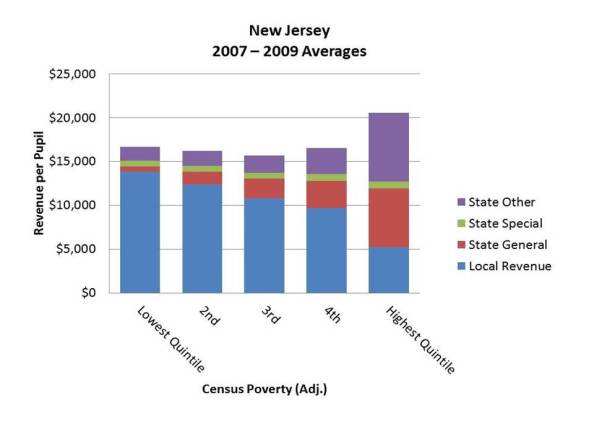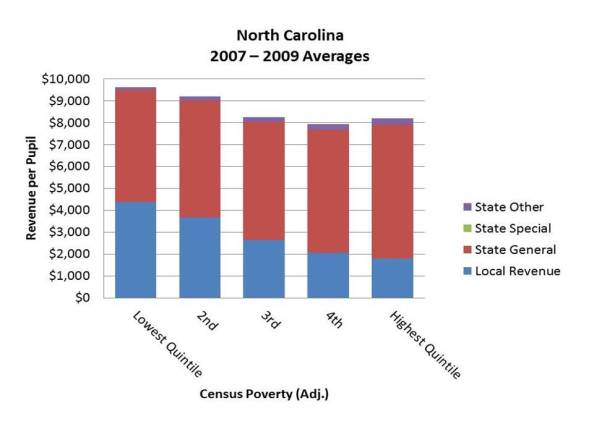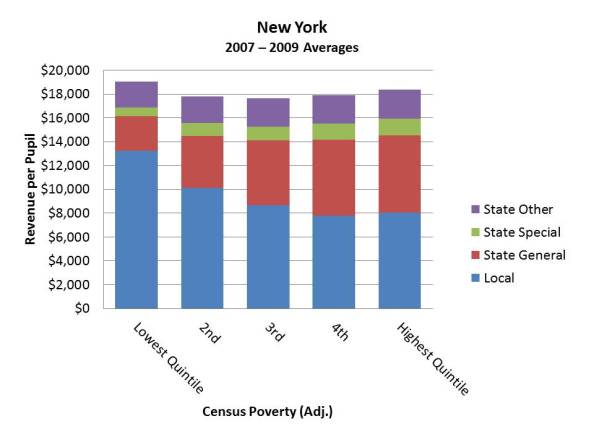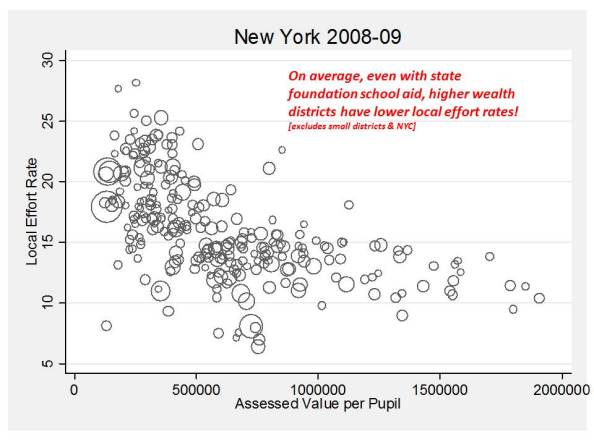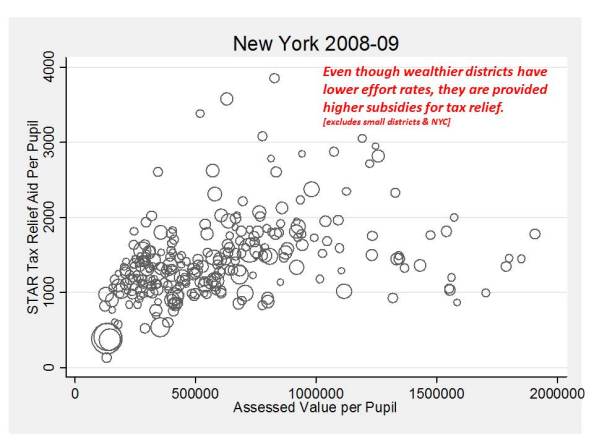Friday Finance 101: On Parfaits & Property Taxes
Public preference for property taxes stands in perfect inverse relation to the public taste for parfaits. Everybody loves parfaits[i] and everybody hates property taxes.[ii] No, I don’t plan to spend this blog post bashing parfaits. I do like a good parfait. But, even more blasphemous, I intend to shed light on some of the virtues of much maligned property taxes.
I often hear school funding equity advocates argue that if we could only get rid of property taxes as a basis for funding public schools, we could dramatically improve funding equity. The solution, from their standpoint is to fund schools entirely from state general funds – based on rationally designed state school finance formulas – where state general fund revenues are derived primarily from income and sales taxes. In theory, if the state controls the distribution of all resources to schools and none are raised locally through property taxes, the system can be made much fairer, even more progressive with respect to student needs and cost variation (as I discuss in this post).
Property Taxes are Less Volatile and their Decline (when/if there is one) Lags
The most recent cries for why the property tax is problematic came about because property tax revenues in some locations continue to decline marginally even as state revenues are rebounding! Damn those property tax revenues! Why don’t they rebound too?
As reported in The Atlantic, the question was: why are we still firing teachers even as the economy is rebounding (albeit slowly)? The answer- declining home values and thus declining revenues from taxes on those home values. Mind you, residential properties are only a share of taxable property values, and a much smaller share in some districts/locations than others. But more on that later.
The article in the Atlantic pointed to U.S. Census data on tax collections which are also summarized in recent reports from the Rockefeller Institute (www.rockinst.org), one of my most trusted sources for information on state and local tax policy. Consistently good stuff! Figure 1 shows the fluctuations in state and local tax revenue sources over time. And yes, Figure 1 does show that property tax revenues continue to decline modestly. But figure 1 also shows that property tax revenues a) have much more consistently stayed in the positive zone since the early 1980s and b) have generally been much less volatile than income or sales tax revenues. Look at the most recent two downturns, in 2002-03 and 2009 to present.
Personal income tax revenues are most volatile, especially in states where larger shares of income are non-wage income. You certainly don’t want all your eggs in that basket. And it was, in fact, state budgets that got most slammed, especially in states most reliant on personal income tax. Now this is not a case for eliminating the personal income tax. What goes down also goes up. And the personal income tax can be structured progressively and revenues from it can be distributed to improve equity. In education – or really any public service financed by a mix of income, sales and property taxes – property taxes serve as a buffer to the system – a stabilizer. While that buffer is not fairly distributed – wealthy communities having greater ability to buffer their aid losses than poorer ones – states could responsibly redistribute remaining state aid to those who need it most, or at least levy cuts in a pattern least harmful to the most needy, accounting for those with the strongest buffer. (which is not to say that states do, but rather that they could).
Figure 1. Rockefeller Institute Analysis of Revenue Volatility
 http://www.rockinst.org/pdf/government_finance/2012-07-16-Recession_Local_%20Property_Tax.pdf
http://www.rockinst.org/pdf/government_finance/2012-07-16-Recession_Local_%20Property_Tax.pdf
The other point here that The Atlantic latched onto is that property tax revenue decline, if and when it happens, occurs in a lag. They decline after others start going back up. So yes, while it does suck that property tax revenues haven’t rebounded right away, it sucks a lot less than if property tax revenues had tanked to the same degree and at the same time as sales and income tax revenues. Further, the blow of declining property tax revenues could now be softened with the political will to tap rebounding incomes and sales. (yes… could…)
Having these revenue cycles, be, well… off cycle with one another is helpful… or at least less harmful.
In short, for all their other faults property taxes help balance the revenue portfolio for public services. They are the stable, safer investment in that portfolio. Shifting too dramatically away from property taxes places a greater burden on the state to provide additional state aid for property wealthy and property poor districts. And we know who’s likely to win out in that tug of war.
Overall Funding Equity is NOT a Function of Whether the State Pays a Larger Share
Now here’s the real kicker. While school funding equity advocates like to believe that fully state funded systems would somehow be magically more equitable because state share has increased, it is not generally the case that states where school districts are more reliant on local revenue have less equitable school funding systems. In fact, as we found in our school funding fairness report, there exists no relationship at all between overall school funding fairness and the percent of money that comes from state versus local resources. Figure 2 illustrates this stunning lack of relationship.
Figure 2. Relationship between State Share and Funding Fairness
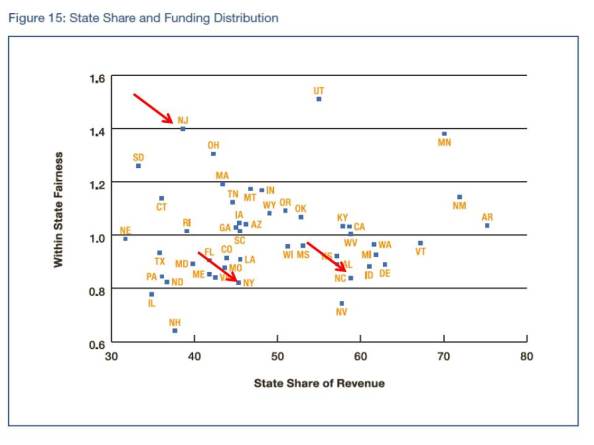 http://schoolfundingfairness.org/downloads_popup.htm# (2010, p. 35)
http://schoolfundingfairness.org/downloads_popup.htm# (2010, p. 35)
How can that be? Why, if more money comes from the state wouldn’t that improve funding equity? Clearly the ability to raise funds from local property taxes is inequitable? Thus, state aid is needed to counterbalance that inequity. More state aid, more equity! Viola.
But alas, as I’ve discussed many times previously on this blog, state aid formulas are the output of an ugly political process – and that’s just how it has to be. I’d love to substitute my infinite wisdom for the political meat-grinder – but that would be about as arrogant and disrespectful to our American political system as… well… executive waivers from Federal statutory obligations. In fact, it would be equivalent to trying to use executive or regulatory (departmental) authority to rewrite components of a state school finance system that are spelled out in statute. Nah… that would be just wrong!
Some times, as in Figure 3, the political meat-grinder, under some influence of that other branch of state government – the judicial branch – produces a state school finance system that, while heavily reliant on local property taxes, still manages to achieve pretty darn good relative equity. See Figure 3- New Jersey.
Figure 3. Equitable state w/Heavy Property tax Reliance
But other times, even when a state school finance system is heavily state funded, with relatively small local share, that system still ends up incredibly inequitable and regressive with respect to student needs. See Figure 4 – North Carolina.
Figure 4. Inequitable State with Low Property tax Reliance
And yes, sometimes, you do have a state that is very heavily reliant on local property taxes and has a very inequitable distribution of resources, like New York! But hey, at least it’s a stable inequity over time, right?Nothin’ like dramatic disparities that stand the test of time!
Figure 5. Inequitable State with Higher Property Tax Reliance
And every state’s a bit different from every other – creating its own brand of state endorsed inequities – seemingly regardless of how dependent, or not, that state system is on local property taxes.
General State Equalization Aid IS Property Tax Relief Aid to those who need it most!
Now, it’s not entirely the fault of the property tax that we have these disparities in states like North Carolina and New York. Clearly something else is going on. I won’t go too deep on that here, because I’ve got a really fun paper coming out this September in which I go painfully deep on this topic. The paper will be rolled out in a public event in DC – more on that later. But clearly, if states more reliant on property taxes are not generally less equitable, there’s other stuff going on. Hey, just look at all of that state aid in North Carolina going to the lowest poverty districts, even when higher poverty districts could likely use a bit more. And what about the aid going to the wealthiest New York districts, a topic I’ve written about many times here? How does state aid get so screwed up as to not help?
One common argument among state legislators, especially those from property wealthy communities is that their communities need property tax relief. It’s easy to hold up the tax bill on a $2 million dollar home in New York or New Jersey and get an eye-popping response. What? You mean you pay over $30,000 a year in property tax? Clearly you need tax relief! Uh… but wait, despite the eye-popping tax bill, the effective tax rate on that house might just be lower than the effective tax rate on the $200,000 home in Newark, NJ or Utica, NY! The tax bill is high because of the value of the house, not because of some unfair tax policy or aid distribution scheme.
The bottom line is that general state aid to schools – the equity enhancing aid – is already designed to promote tax equity. State aid to schools and property tax relief, are, to a large extent flip sides of the same coin. When a community gets more in aid, they need to raise less locally to achieve the desired quality of service. If they get less in state aid, they need to raise more. Communities with greater capacity to raise more should, in turn, get less. There’s no reason to then turn around and say that those with greater capacity to raise more all of the sudden need a break… and need additional aid… that could have otherwise gone to those with less capacity? Such an argument presumes that the state has already over-corrected tax inequities between rich and poor communities. Highly unlikely! Even New Jersey, which has corrected more than many by providing aggressively targeted state aid hasn’t gone that far. See this post! Effective tax rates remain lower in NJ districts with higher property values (at the peak of aid targeting).
New York certainly hasn’t “over-corrected,” the property tax burden across districts, warranting the counterbalancing distribution of un-equalization aid. Figure 5 shows the relationship between taxable property values per pupil and local effort rates. Local effort rates remain systematically higher in lower wealth communities.
Figure 5. Insufficient General Aid and Persistent Tax Inequities
But, as I’ve discussed on a number of occasions on this blog previously, New York still goes out of its way to operate a completely separate property tax relief subsidy program, which on average, spends more state resources each year to buy down property taxes in richer rather than poorer communities. See Figure 6.
Figure 6. Un-equalizing Distribution of Unnecessary Aid
So the point of this seemingly tangential portion of this post is that states like New York and others, find ways to consume state resources toward making school funding less equitable. It’s not entirely the property tax that’s at fault here. Rather, it’s the use of state resources to buy down property taxes in wealthy communities – actually encouraging even more spending in these communities that already have greater capacity and are exerting less effort. Go figure.
And that’s ONE OF MANY REASONS why simply increasing the level of support coming from the state doesn’t always improve school funding equity. Heck, North Carolina barely even tries to equalize (adjust) general school aid for differences in local capacity. You get more or less the same state aid per pupil no matter how wealthy or poor. Thus, whatever disparities exist in local revenue are simply added onto with state aid.
Closing Thoughts
There are lots of ways to make property taxes “better” and “fairer.” But even in their current form, property taxes play an important role in stabilizing the revenue on which our public schooling system operates. Further, overemphasis on the classic, savage inequalities of American public schooling that emerge from the inequitable mess that is property taxation may distract from the reality that state school finance systems often make things worse rather than better, replacing savage inequalities with stealth inequalities.
The solution is not to get rid of property taxes but to integrate them wisely into state school finance systems, use other state revenues to better achieve overall funding equity by aggressively targeting those revenues, count on property taxes as a portfolio stabilizer and, to the extent possible, seek ways to improve equity with property taxes and improve the equity of property taxation.
[i] Donkey (2001) Shrek.
[ii] http://businessweekly.readingeagle.com/?p=2860 (okay, this is an indirect cite to the Tax Foundation, which isn’t really the most credible source on Tax Policy. See:http://schoolfinance101.wordpress.com/2010/03/17/just-the-facts-nj-taxes-teacher-salaries-and-spending-fluff/)
This blog post has been shared by permission from the author.
Readers wishing to comment on the content are encouraged to do so via the link to the original post.
Find the original post here:
The views expressed by the blogger are not necessarily those of NEPC.
